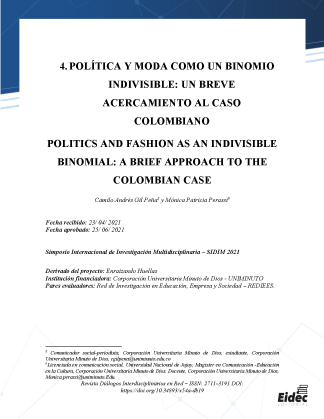IV. POLITICS AND FASHION AS AN INDIVISIBLE BINOMIAL: A BRIEF APPROACH TO THE COLOMBIAN CASE
##plugins.themes.bootstrap3.article.main##
Abstract
Fashion and clothing have been considered as ornamental elements in societies,
however authors such as Bourdieu have raised the association and its use in politics as a
support strategy for political careers. While clothing is configured as an element of material
culture, this work focuses on the identification of these elements in Colombia from the
recognition of the population of these elements, as well as the identification of them in the
case of Claudia López (current mayor of Bogotá). Through an analysis of three particular
photographs of the mayor, as well as a survey of open questions for the recognition of
elements or imaginaries of the binomial fashion/politics with young people, it was possible
to identify the particular elements such as: the ruana, the pants, informal dress. Each of them
was reported from the particular categories. The ruana, as an identifying element of social
groups such as the peasantry, which reinforce the sense of belonging and are associated with
“simplicity” and “humility”. Pants, as an element of the genre (skirt vs pants) is synonymous
with “strength” and “leadership”. Finally, the casual dress, which breaks with protocol
patterns and is associated with terms such as”rebellion". In any case, all these elements
constitute identifiers that generate affinity or rejection in the subjects, being in young people
the highest degree of affinity
Download Statistics
##plugins.themes.bootstrap3.article.details##
Fashion, Comunication, Politics, Colombia.
65.
Arendt, H. (1997). ¿Qué es la Política? Ediciones Paidós.
Arendt, H. (2007). Responsabilidad y juicio. Ediciones Paidós.
Blanco Macías, A. (2015). La influencia de la política y los movimientos sociales en
la evolución de la moda en España: la movida madrileña. [Tesis de grado] Universidad de
Sevilla. https://idus.us.es/handle/11441/32677
Bourdieu, P. (1998). La distinción. Madrid: Taurus.
Cabrera Arus, M. (2015). Pañoletas y polainas. Dinámicas de la moda en la Cuba
Soviética. Kamchatka, 5. Pp. 243-260. 10.7203/KAM.5.4577
Canel Crespo, M. (2006). Comunicación política Una guía para su estudio y práctica.
Tecnos.
Castoriadis, C. (1997). El Imaginario Social Instituyente. Zona Erógena. Nº 35.
https://www.ubiobio.cl/miweb/webfile/media/267/Castoriadis%20Cornelius%20-
%20El%20Imaginario%20Social%20Instituyente.pdf
Centeno, P. (2012). Política y Moda, la imagen del poder. Península.
Gómez, S. (2001). Diccionario etimológico de la lengua española. Fondo de cultura
económica.
Lipovetsky, G. (1990). El imperio de lo efímero. La moda y su destino en las
sociedades modernas. Anagrama.
Velasco-Molpeceres, A. (2019). La moda en los medios de comunicación: de la
prensa femenina tradicional a la política y los/as influencers. Prima Social, 24, pp. 153-185.
https://revistaprismasocial.es/article/view/2845.


 https://orcid.org/0000-0002-0488-1621
https://orcid.org/0000-0002-0488-1621



